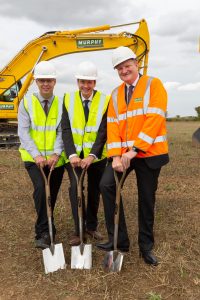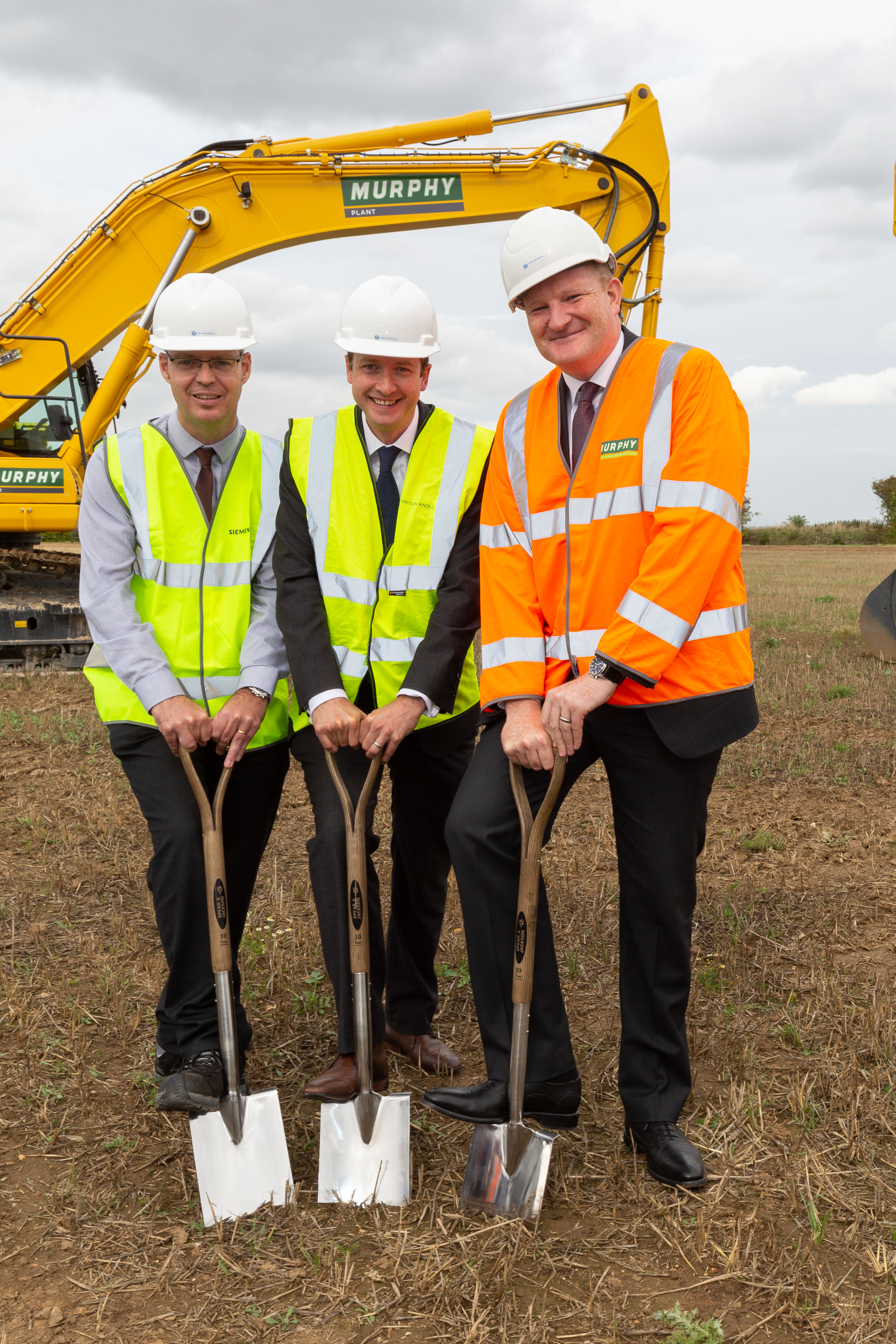-

Triton Knoll officially breaks ground, marking the start of onshore construction. First turf cut at site of onshore cable route sees works start in Lincolnshire
- Work at new electrical substation will commence in early 2019
- Record number of directional drills planned to avoid obstructing roads, drains and rivers.
Triton Knoll onshore construction officially started in Lincolnshire today as the project commenced work on the electrical system to transport power from the windfarm to over 800,000 UK(2) homes.
The official ‘breaking-of-ground’ took place directly on the route of the new high voltage underground export cable, and located at the main onshore cables site offices (TCC12) off the A16 near Stickney.
The two year onshore construction programme for the 860MW project is being managed by innogy, the majority equity shareholder of Triton Knoll (59%) on behalf of partners J-Power (25%) and Kansai Electric Power(16%).
UK firms J Murphy & Sons Ltd and Siemens Transmission and Distribution Ltd (STDL) have been contracted to build the project, and are already carrying out initial works including the establishment of site offices, temporary construction compounds and bell-mouths at key points along the route.
Triton Knoll project director Julian Garnsey was joined by Murphy CEO John Murphy, and STDL’s Project Director Phil Manley, to officially cut the turf on the onshore cable route.
Julian said: “Triton Knoll construction is officially up and running. This moment is the culmination of years of planning, engineering, consultation, and cooperation with our supply chain and stakeholders to produce a state of the art wind farm , which benefits both local and regional economies.
“Triton Knoll is committed to supporting local and regional jobs, skills development and, through our investments, the further strengthening of the UK’s already world-beating offshore industry.
“As we continue to progress through the weeks and months ahead, we and all our contractors look forward to working even more closely with our neighbouring communities, so that local people are aware of our works and how they are progressing.”
Onshore construction presents some significant engineering challenges as Triton Knoll installs over 57km of underground electrical export cable below ground in Lincolnshire. The route starts at the landfall location north of Anderby Creek, where the onshore and offshore cables connect. It runs to a new substation being constructed near Bicker, and then to the existing National Grid Bicker Fen Substation where the electricity from the offshore wind farm will ultimately connect into the grid.
Over 300 individual directional drills – a record for a UK infrastructure project – will ensure the onshore cables can be installed without obstructing any roads, highways, rivers or drains.
Murphy’s CEO John Murphy, said: “The cable route presents an exciting engineering challenge for us and we’ve worked diligently and intelligently to create better engineered solutions that will allow us deliver it with minimum disruption. I’m thrilled to be able to break ground with Triton Knoll and Siemens and kick-start these exciting works. We’re very proud to be working on the Triton Knoll project and with their team who are so firmly committed to leaving a positive legacy in Lincolnshire, an aim we share at Murphy. ”
Work on the new onshore substation will start early in 2019, with Siemens constructing a new facility close to the existing electrical substation near Bicker. Work is already underway to construct a new bellmouth entry point and 3.8km access road to the new substation construction site to ensure that construction traffic can avoid use of smaller local roads.
Phil Manley, Project Director, Siemens Transmission and Distribution Ltd, said: “This nationally significant project will have a vital role in creating energy security for the UK. As one of the lead contractors, making sure the energy created by Triton Knoll gets to the homes and businesses which need it, we play an important role in this project. Our main offshore work will begin in 2019, with work already underway onshore to build a new access road to the substation construction site. We anticipate a number of supply chain contracts will be available for UK supply chain companies, with details to be announced in the coming months.”
Triton Knoll has committed to delivering at least 50% UK content through the construction and operation of the wind farm. At its height, the project expects to see around 3000 people working on both onshore and offshore phases of the project, with potentially up to 170 working long term in support of its Operations & Maintenance activities.
The onshore construction works present one of the most significant opportunities for local firms to benefit from the project’s investment. Both Murphy and STDL have already engaged a number of local companies in preparation for the construction start, and are continuing to seek local and regional companies to further support their work.
The formal start of construction follows a number of key recent milestones for the Triton Knoll project, including the formal launch of a £1.5million community fund, and formal announcement of Financial Close on 31 August, 2018. As part of the latest announcement, Triton Knoll also confirmed it had agreed a deal to assemble and install all 90 x 9.5 MW offshore wind turbines from Able UK’s Seaton port, while agreeing a Memorandum of Understanding for longer term operations and maintenance works out of ABP’s Grimsby Port.
For more information about the project, please visit: www.tritonknoll.co.uk<https://www.tritonknoll.co.uk>
Ends
Media Contacts
Mark Fleming, innogy / Triton Knoll
Senior Public Relations Officer
M: 07825 608096
E: mark.fleming@tritonknoll.co.uk<mailto:mark.fleming@tritonknoll.co.uk>
Chris Mostyn
J Murphy & Sons
M: 07587 036087
E: chrismostyn@murphygroup.co.uk<mailto:chrismostyn@murphygroup.co.uk>
Sara Crane
Siemens plc
M: 07921 847640
E: sara.crane@siemens.com<mailto:sara.crane@siemens.com>
Overall timeline
– Financial Close 31 August 2018
– Start of onshore construction 10 September 2018
– Start of offshore construction end of 2019/Q1 2020
– First generation likely expected 2021
– Commissioning likely to start expected 2021
– Project fully operational expected 2022.
TIMELINE: Onshore cable installation works
– Temporary Construction Compounds installation, topsoil stripping, bell-mouth construction programme – From July 2018
– Start of horizontal directional drilling programme – From Q4 2018
– Start of onshore cable installation – From Q2 2019
– Offshore horizontal directional drilling – From March – May 2019
– Completion of cable route works – Q3 2020
TIMELINE: Onshore substation works
– Installation of access road from A17 – July 2018 – October 2018
– TK Substation enabling works – September 2018 to June 2019
– Access track from TK substation to Bicker Fen substation – October 2018 – January 2019
– TK Substation construction – February 2019 to April 2020 (Incl. M&E)
– Commissioning – March 2020 to August 2020
– Removal and reinstatement of access road from Bicker Fen to TK substation – from September 2020 onwards.
– reinstatement of access road from Bicker Fen to TK substation – from September 2020 onwards
(1) Substation footprint
The buildings that make up the new substation are expected to cover an area of around 4.5hectares. Landscaping to screen the substation buildings could increase the overall footprint of the site up to a maximum of 20 hectares.
(2) Energy Generation
It is estimated that the average annual generation expected at the site could be equivalent to the approximate domestic needs of an expected minimum of 800,000 average UK households.
Energy predicted to be generated by the proposal is derived using wind speeds monitored in the local area and correlated with long term reference data. The energy capture predicted and hence derived homes equivalent figure may change as further data are gathered.
Equivalent homes supplied is based on an annual electricity consumption per home of 4100 kWh. This figure is supported by recent domestic electricity consumption data available from The Digest of UK Energy Statistics and household figures from the UK National Statistics Authority.”
About innogy SE
innogy SE is a leading German energy company, with revenue of around €43 billion (2017), more than 42,000 employees and activities in 16 countries across Europe. With its three business segments Renewables, Grid & Infrastructure and Retail, innogy addresses the requirements of a modern, decarbonised, decentralised and digital energy world. Its activities focus on its about 22 million customers, and on offering them innovative and sustainable products and services which enable them to use energy more efficiently and improve their quality of life. The key markets are Germany, the United Kingdom, the Netherlands and Belgium, as well as several countries in Central Eastern and South Eastern Europe, especially the Czech Republic, Hungary and Poland. In renewable power generation, the company is also active in other regions, e.g. Spain, Italy and the USA, with a total capacity of 3.9 gigawatts. As a leader of innovation in future-oriented fields like eMobility, we are represented in the international hot-spots of the technology industry such as Silicon Valley, Tel Aviv and Berlin. We combine the extensive expertise of our energy technicians and engineers with digital technology partners, from start-ups to major corporates.
Renewables
We plan, build and operate plants to generate power and extract energy from renewable sources. Part of our portfolio are wind and hydro power plants as well as solar and biomass plants. Currently, we are particularly strongly represented in our home market, Germany, followed by the United Kingdom, Spain, the Netherlands, Poland and Italy. Our aim is to expand renewables in Europe further, both on our own and working with partners. We believe that working together in this way is the key to making the energy transition a success. With an installed capacity of more than 925 megawatts in offshore wind and with over 2100 megawatts in onshore wind, innogy is one of the major operators in Europe. At the moment we are focusing on continuing to expand our activities in wind power. That’s why, in addition to our core markets, we are already active in new markets such as the USA and Ireland. Another growth technology is the construction of utility-scale photovoltaic power plants – for example in Australia.

